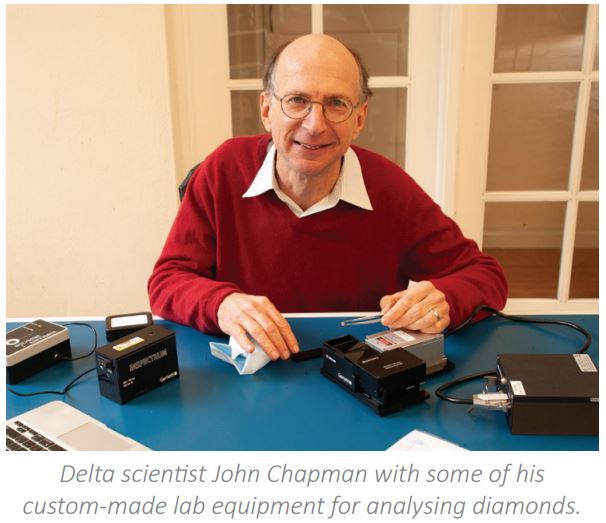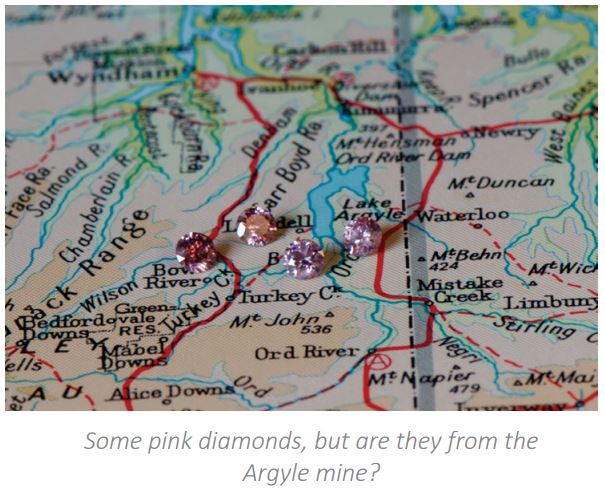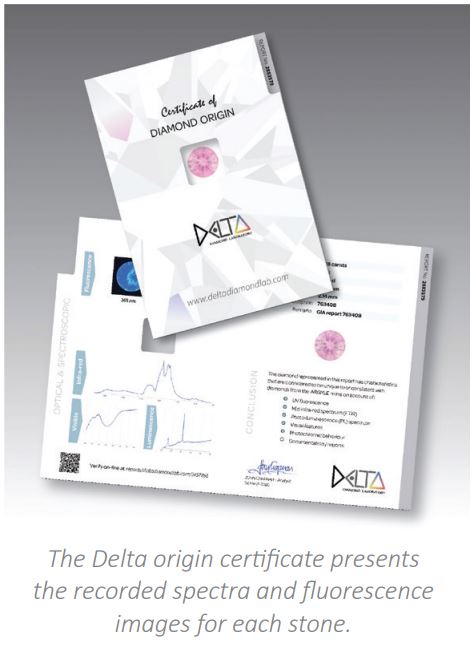The provenance of a diamond can have significant implications on its value. John Chapman has established Delta Diamond Laboratory primarily to address demand for certifying the origin of pink diamonds from Argyle.
Provenance plays a strong part in the gem industry, especially with coloured gemstones where, for example, a Burmese ruby can attract a significant premium over a similar quality stone from another country. Similarly, sapphires from Sri Lanka also enjoy a healthy premium. Because of the significant price influence of source, major gem labs have developed a capability to distinguish between the sources usually on the basis of trace impurities and, in some instances, inclusion types.

In the late 90s, diamonds fell under the spotlight because of the conflict diamond issue and while there were several large-scale studies to attempt to be able to identify the country of origin of a diamond, no satisfactory result was obtained. It was also recognised that any solution would be limited because an alluvial diamond could be flushed from a conflict country into a non-conflict country. While distinctions could be made between different sources, in many instances the prospect of a ‘fingerprint’ for origin was abandoned.
In recent years, discussions of diamond origin have been revived as consumers demand knowledge of a diamond’s source.
Sometimes the reason is patriotic (eg. Canadians preferring Canadian sources) or buyers not wanting a gem from a particular country for political reasons. The industry has responded to this consumer demand primarily by implementing a ‘chain of custody’ tracking system from mine to market, though it is usually a ‘bulk’ process for parcels of diamonds and such documented assurances usually stop at the jeweller when diamonds are singled out from parcels.
One particular type of diamond that has received special consumer attention is the Argyle pink. On account of marketing over decades, pink diamonds have become synonymous with Argyle and customers are prepared to pay a premium for such provenance (even though pink diamonds from other sources are much rarer!) The premium varies and is considered to be as high as 25%.

Argyle Pinks Diamonds – a subsidiary of the mine’s owner, Rio Tinto – has been issuing certificates with individual pink diamonds since the early days of the mine. However the size and quality of stone that qualifies for a certificate has changed over time. Consequently there are many pink diamonds from the Argyle mine that do not have a certificate or, in some instances, the document has been lost.
A new laboratory in Perth has been established focussed on confirming the origin of a pink or blue-violet diamond from Argyle. Delta Diamond Laboratory is the initiative of John Chapman who has been active in the industry for over 35 years. Much of this time he spent as a scientist working at Argyle diamonds and, with his physics degree, took a special interest in the causes of colour in the mine’s diamonds. Besides his own studies, he was closely involved in three PhD studies on Argyle pink diamonds, co-supervising the most recent thesis at the University of WA.

The outcome of this research has armed John with a deep understanding of the properties of the Argyle diamonds and how they are distinct to those from other mines. His lab records multiple properties using ultra-violet, infra-red light and two different lasers. The interactions produce signatures that are presented in the Delta certificate issued by the lab.
Nitrogen is the main impurity in diamond that can bond with other nitrogen atoms and vacancies at levels that depend on the temperature and durations experienced after growth. These conditions impart nuances to the spectra and optical behaviour specific to the pinks from Argyle. John explains that some of the proprietary features are subtle and require special processing of spectra to identify them.
The certificate features photos of the fluorescence and also spectra, though two key optical features relating to fluorescence and colour are noted with the eye and are not presented.
Blue/violet diamonds from the Argyle mine are also distinctive and a similar suite of tests are performed to verify their provenance. Besides certifying origin for Argyle pinks and violets, Delta can also assess diamonds to determine if they have been artificially grown or colour treated.
The origin certificate does not offer any grading of colour or clarity and only certifies origin however, such origin certification is a valuable asset to those wishing to sell their pink diamond if it is from the Argyle mine. John, a physicist specialising in optics, has designed most of the instruments in the laboratory and has made them exceptionally compact with the intention of being able to make the lab ‘portable’ so that tests can be performed at a client’s premises far from the labs base in Perth.
For more details about Delta’s services visit their website here.